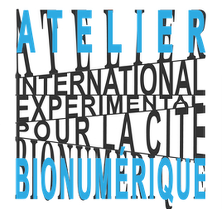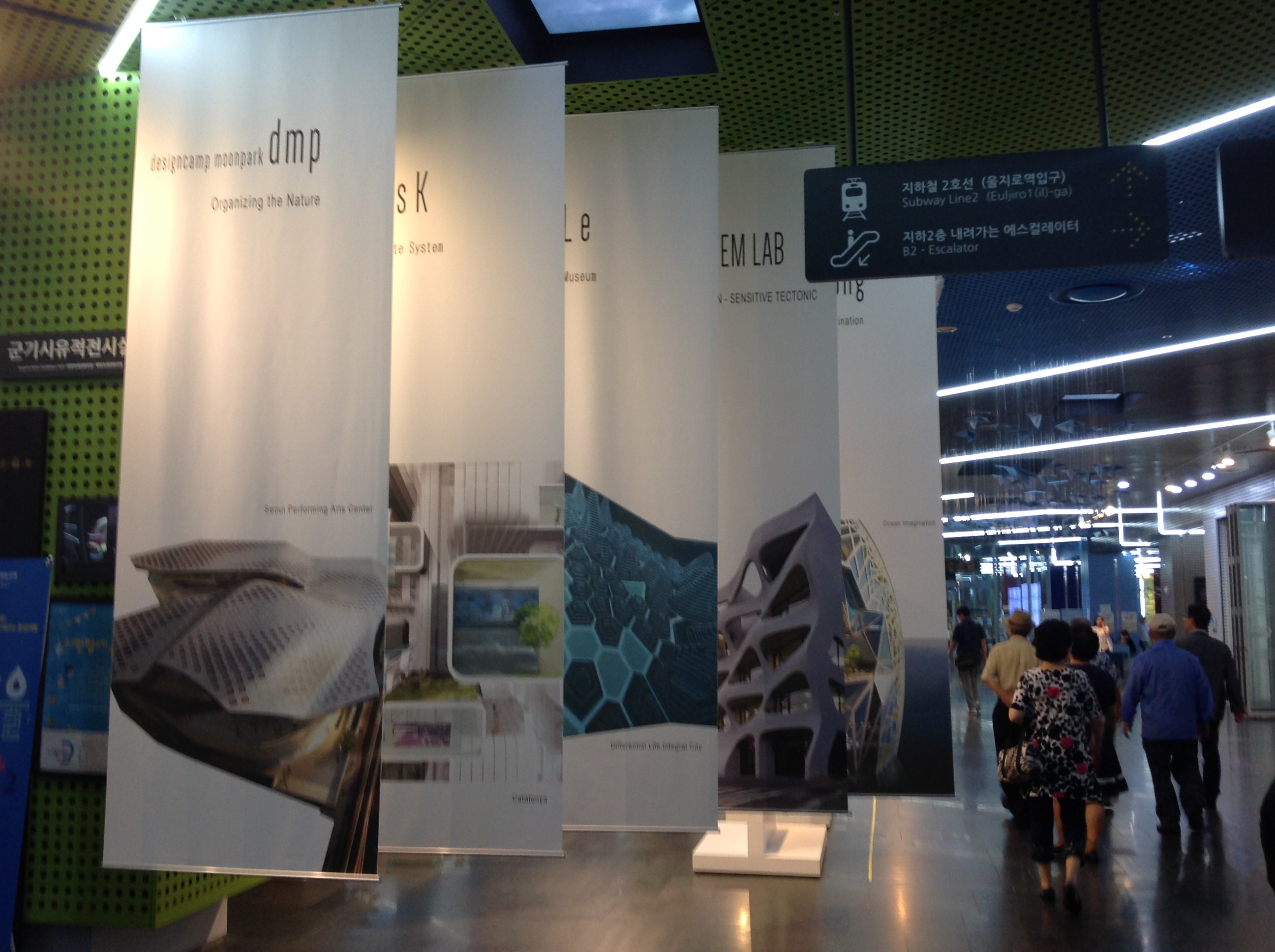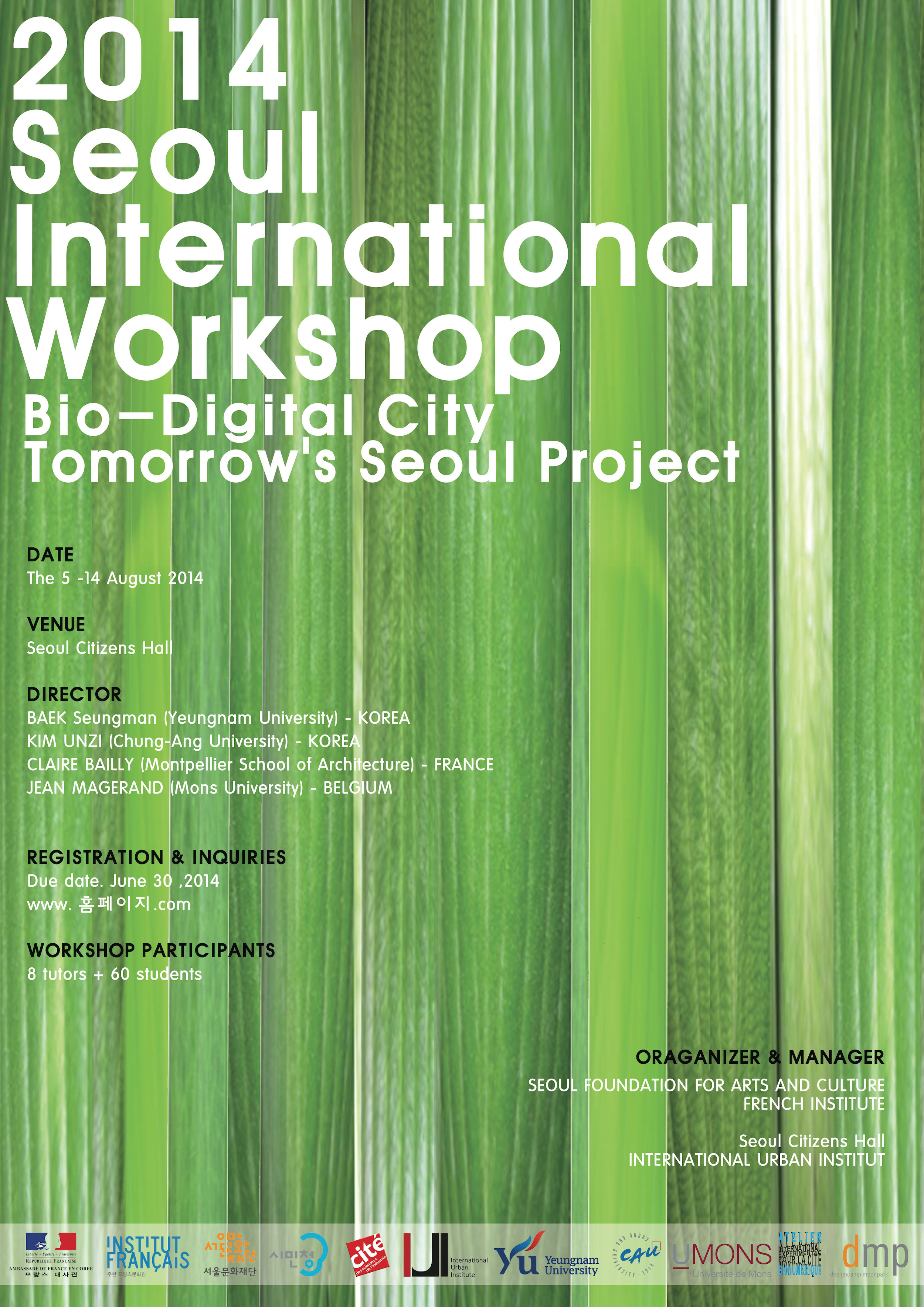Author Archives: biodigitalcity
UIA 2017: "Paris-Seoul 2017 Workshop & Exhibition: Bio-Digital City"/The photos
 Opening of the UIA World Congress 2017 S Continue reading
Opening of the UIA World Congress 2017 S Continue reading
The UIA-invited bio-digital workshop to organize a workshop at its 2017 World Congress in Seoul
 The experimental laboratory of the City of Science and industry in Paris is invited by the UIA (International Union of Architects) for its World Congress in Seoul, which will take place from 3 to 7 September 2017: Http://www.uia2017seoul.org on Continue reading
The experimental laboratory of the City of Science and industry in Paris is invited by the UIA (International Union of Architects) for its World Congress in Seoul, which will take place from 3 to 7 September 2017: Http://www.uia2017seoul.org on Continue reading
Workshop + exhibition UIA Seoul 2017: Bio-digital as soul of the city
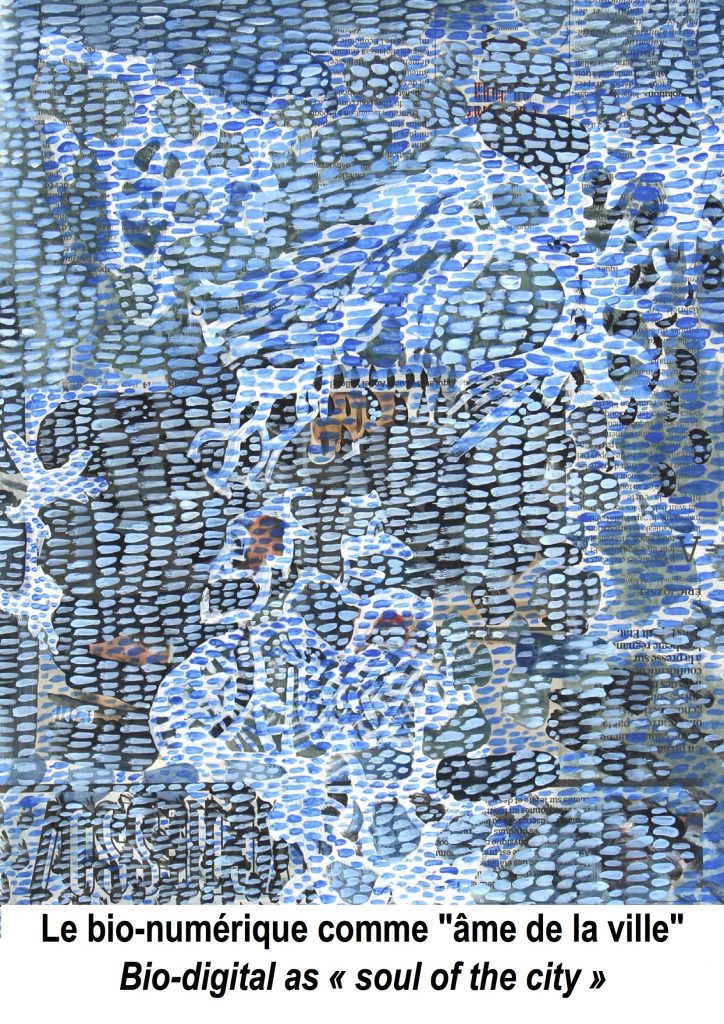 Towards the complex projétation the international Bio-Digital thought movement is developing on a Franco-Korean axis. It brings together academics and creatives. These specialists reconcile new methods of scientific analysis and new approaches to creation and development. They want to meet the new demands of the people and meet the new planetary constraints. This movement of thought is interested in the new methods of Constitution/re-constitution of the real proposed by the digital and the biological. How can the parameterization, the algorithm, the Écosystémie, the self-organization, fertilize and enrich the project approaches in the fields of architecture, urbanism, landscape, agriculture, governance, art, Sustainable development? That is the central question. The new approaches of projétation are to be examined. Continue reading
Towards the complex projétation the international Bio-Digital thought movement is developing on a Franco-Korean axis. It brings together academics and creatives. These specialists reconcile new methods of scientific analysis and new approaches to creation and development. They want to meet the new demands of the people and meet the new planetary constraints. This movement of thought is interested in the new methods of Constitution/re-constitution of the real proposed by the digital and the biological. How can the parameterization, the algorithm, the Écosystémie, the self-organization, fertilize and enrich the project approaches in the fields of architecture, urbanism, landscape, agriculture, governance, art, Sustainable development? That is the central question. The new approaches of projétation are to be examined. Continue reading
Towards a bio-numérique city / Claire Bailly and Jean Magerand invited to the Cité des Sciences with Thierry Paquot
As part of the cycle of conferences “Cities of the Future: New Utopias?”, the City of Science and Industry organized a conference confronting the viewpoints of Claire Bailly and Jean Magerand, with those of Thierry Diquot.
The conference was held on June 14, 2016 and was presented in these terms:
Imagine a friendly city, integrating local work, designed for pedestrians and bicycles, promoting biodiversity, mastering recycling and short circuits, hybridizing knowledge, cultures and functions, respecting the health, sensitivities and well-being of individuals. Utopia? With Claire Bailly, architect Urbanist researcher at the laboratory virtual space in architectural and urban design (EVCAU) of the School of Architecture of Paris-Val-de-Seine (ENSAPVS); Jean Magerand, architect, researcher at the Laboratoire EVCAU (ENSAPVS), Teacher of the prospective pole at theArchitecture Faculty of Mons University (Belgium); Thierry Paquot, urban philosopher.
<
6 Conferences to feed the workshop "resilient, climate and digital Habitat"
Meetings from Tuesday 16 to Sunday 21 February at 15h: Tuesday 16 February: “Imagining architecture as a partition” by Cédric Brandilly-plastic urban analyst. Wednesday, February 17: “What City in 2030?” George-Director of the corporate program “City and Building of Tomorrow” Direction Research and Technology ENGIE. Thursday, February 18: “Representations and dynamics of the city” by Gilles Gesquière-professor at the University Lumière Lyon 2 researcher at LIRIS at the CNRS vendredi19 February: “Digital Technologies, City and Architecture: What Stakes for Tomorrow?” by Serge Wachter-Professor at the ENSAPLV Saturday 20 February: “Living environment and digital solidarity” by Claire Bailly-landscape architect, teacher-and Jean Magerand-landscape architect teacher Sunday 21 February: “Social housing in the European Union” Soviet: Training and mutations “by LiudmilaPiskareva-PhD student Université Paris Diderot
Conference of Marcos Novak//experimental laboratory in residence at the city of Sciences
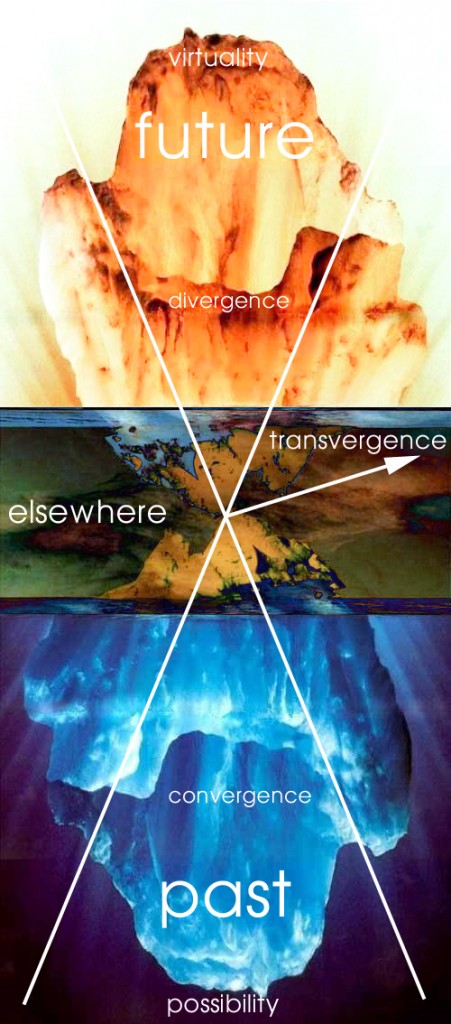 The experimental laboratory in Residence Presents: Conference of Marcos NOVAK in the city of science and Industry, on 27 November 2015 at 10.30 am transverging Fate Maps: From the AlloBio to the city bio-Digital Continue reading
The experimental laboratory in Residence Presents: Conference of Marcos NOVAK in the city of science and Industry, on 27 November 2015 at 10.30 am transverging Fate Maps: From the AlloBio to the city bio-Digital Continue reading
Biodigital hypercites
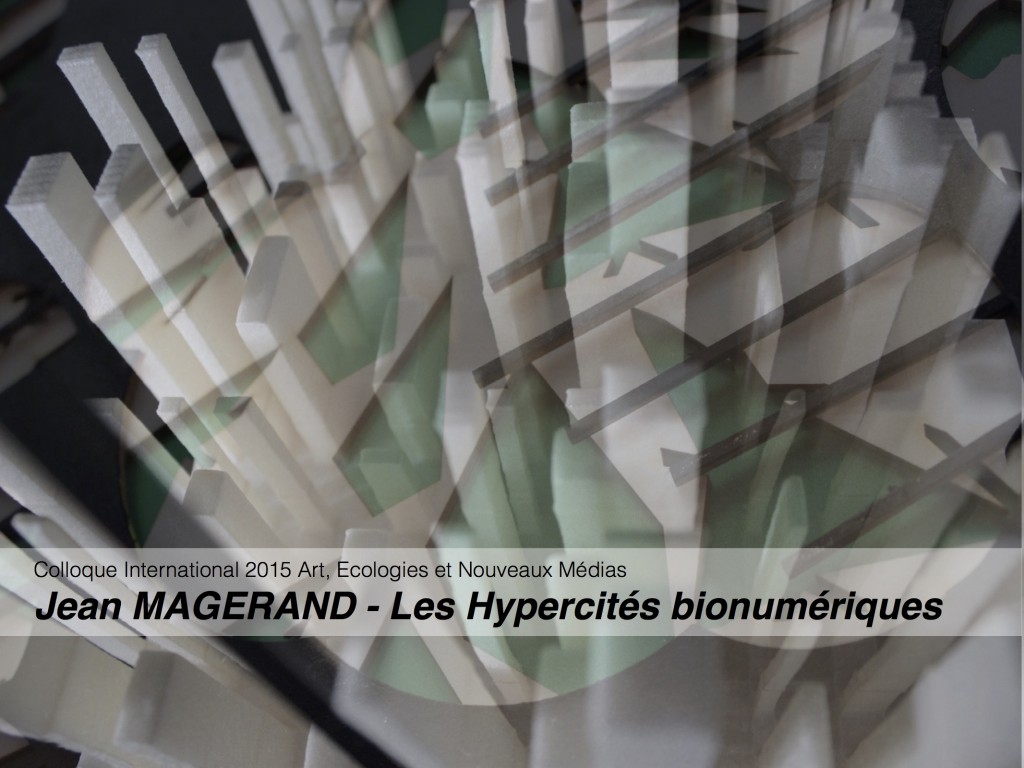 Conference of Jean Magerand International Symposium 2015 ART, Ecology and new media at the Université Toulouse 2-Jean Jaurès, Toulouse, from 22 to 24 October 2015 Continue reading
Conference of Jean Magerand International Symposium 2015 ART, Ecology and new media at the Université Toulouse 2-Jean Jaurès, Toulouse, from 22 to 24 October 2015 Continue reading
"To complex city, augmented urban project?"
Text by Claire Bailly, published in the collective book Urbanism in sharing, under the direction of Lau rent Viala fourth cover: Continue reading
rent Viala fourth cover: Continue reading
Doctorates "prospective architectures" at the Faculty of Architecture and urbanism of Mons
Thesis Director: Jean MAGERAND These few lines are intended to specify, for future PhD students, research leads that can be deepened within that doctoral course. The latter is based on a Belgian-Korean axis linking the faculty of Architecture and Urbanism of the University of Mons and the Faculty of Architecture of Yeungnam University in Daegu, South Korea. Continue reading
The Seoul 2104 Workshop in video
Director G. Go with the support of the French Institute in South Korea and Universcience Http://www.youtube.com/watch?v=EUdcVsEAFFE
The exhibition: 5 Architects and 5 artists
The hip-Hop clip Workshop
Korean artist KIM Kent produced a music video and composed an original soundtrack from the workshop’s work:
2014 Seoul International Workshop Bio-Digital City tomorrow Seoul Project
Workshop in Seoul (Seoul Citizen Hall)
 This workshop is a workshop of MediArchi (Media + architecture), with international students in architecture, urbanism, landscape and multi-media advanced. This workshop is held at the same time as 2 conference days involving experts, and an exhibition of ‘ 5 artists + 5 Architects ‘ around the theme “Bio-Digital”. The event is also an international cooperation between the City of Seoul and the French Embassy in Korea.
This workshop is a workshop of MediArchi (Media + architecture), with international students in architecture, urbanism, landscape and multi-media advanced. This workshop is held at the same time as 2 conference days involving experts, and an exhibition of ‘ 5 artists + 5 Architects ‘ around the theme “Bio-Digital”. The event is also an international cooperation between the City of Seoul and the French Embassy in Korea.Partners Seoul Citizen Hall, Embassy of France in Korea, Seoul Citizen Office, International Urban Institute, Universcience/Cité des sciences et de l’industrie in Paris, Yeungnam University, French Institute, Université de Mons (Belgium), International Workshop for the Biodigital city, DMP Partners (Seoul)
Baek SeungMan (University Yeungnam Direction ensemble), Son Sukyoung (Deojum Art Centre, exhibition), Choe Jeongpil (Seoul Civil Administration, Production space supervisor), Kim Gihong 1 (Kyosks, Executive adviser), Kim Gihong 2 (( 3d printing), Bak Hyerin (Ewha Women’s University, ensemble design)
Chronicle | The city of data is good to take

Last December, the French government opened its interdepartmental portal data.gouv.fr, relaunching the debate on L”open-data ‘. In residency at the lyrical Gaîté, students from ESAG-Peninghen worked last semester on the theme ‘ We Are Data ‘. A loan for a rendition? Continue reading
Chronicle | The architect and the ‘ augmented ‘ analysis: what project approach?
 How can we grasp the notions of probability and uncertainty since the data city exists? As part of a project, can passing these datas to the filter of predictive analysis be a possible way of giving them meaning? What problems arise at the intersection of these two elements? Artic Continue reading
How can we grasp the notions of probability and uncertainty since the data city exists? As part of a project, can passing these datas to the filter of predictive analysis be a possible way of giving them meaning? What problems arise at the intersection of these two elements? Artic Continue reading Chronicle | The Attali report, or the revival of Utopias?

In a guided analysis of the Attali report, the architect and urban planner Jean Magerand assumes the role of Candide; It does not address the problems that are annoying because it is the working method and the areas of design, environment and construction, in the broad sense, that have taken its attention. A useful model? Prospective chronicle. Continue reading
Chronicle | From academicism to foresight

Why a prospective and architecture section? Because we must respond to an expectation too long dissatisfied, because we suffer from a time that is polarizes especially on the present and the short term and so little on the future, and because, more simply, we like to look at the distant future the Eyes in the eyes. Prospective chronicle of Jean Magerand and Claire Bailly. Continue reading
Chronicle | Foresight as a tool for analyzing a "modernity-true"

What quality (s) for the Branly Museum of Jean Nouvel with regard to essential values constituting the new culture in the process of establishing itself in our civilization? In the field of architecture, the world of ideas would remain blind to the transformations of the contemporary world? Prospective chronicle of Jean Magerand. Continue reading
Chronicle | What are future architects dreaming about?

When we talk about foresight, what could be more normal than to evoke the rising generation of architects. I have chosen to present five students diplômables among those who have enrolled in the "prospective group" which I animate at the School of Architecture of Paris-la-Villette. Prospective chronicle of Jean Magerand.
Chronicle | Will high environmental quality (HQE) kill architecture?

The recent Grand Prix of Architecture, Rudy Ricciotti, has blasted the new HQE standards, insisting that architects will be bridled in their creativity. According to him, over-insulations and removals of thermal bridges will bundle the architectural hardware in their binding and unsightly coat. Prospective chronicle of Jean Magerand.
This column was first published on CyberArchi on September 20, 2007
Chronicle | A true modernity… Why not?

Promoting a forward-looking speech requires constant attention to anything that can significantly influence the evolution of contemporary thought. In history, the future often begins with an evil-being in the present, whose symptoms are only discerned, most of the time harmful, without being able to perceive neither the causes nor the mechanisms.
Chronicle | Prospective Chronicle

Working and expressing oneself on foresight inevitably leads to a critical look at our contemporary ways of doing and thinking. Foresight disturbs the conformism and therefore requires, to express itself fully, a medium of free expression. Also, when Christophe Leray asked us to open a forward looking section in the architect's mail we did not hesitate. Continue reading
Chronicle | To urban hyper-density?

Chronicle | Emmanuel Natchitz: ICT City needs competent specialists

Making life easier in the city with new methods? Since September 2010, it is the goal of the new master specialized URBANTIC launched by the School of Engineering of the city of Paris (E.I.V.P.) soon joined by the Ecole des Ponts Paris Tech. A training based on an observation: new knowledge can improve the quality of life in the city. Prospective chronicle.
Chronicle | Who’s afraid of new utopias?

In the face of environmental urgency, ‘ recessionary ‘, ‘ revisionist ‘ or ‘ revolutionary ‘ utopias are Flores today. Whatever the future they are destined for, these systems of thought imply that a transformation of the living environment will take place. But which one? Prospective chronicle signed by Jean Magerand. Continue reading
Chronicle | When Utopia and operational techniques rub shoulders

Chronicle | A human transcended for an interactive architecture?

In his book ' The Interactive City-Architecture and urbanism at the risk of digital and ecology ' *, Serge Wachter, professor of architecture, wonders about the impact of new techniques on architectural and urban thinking. He points out here some of the essentials of his speech on new approaches to city life. Continue reading
Chronicle | To architects, inventory duty

"In many respects, the digital world is a world of generalized ornament," says Antoine Picon *, a Harvard professor. "originally presented as synonymous with a dangerous dematerialisation, the diffusion of digital tools has, in fact, contributed to the question of materiality," he says. Three-part meeting * *.
